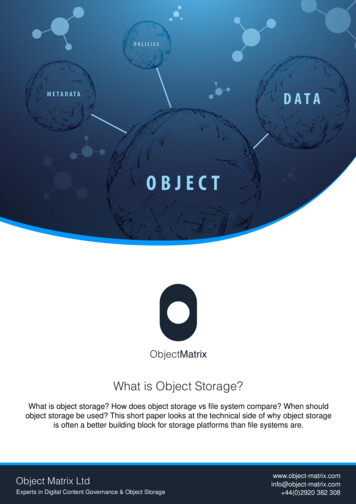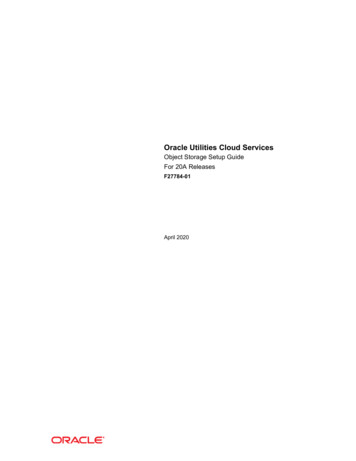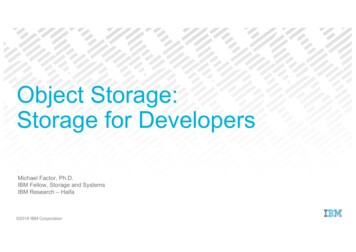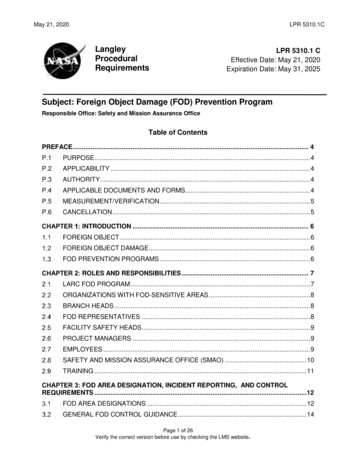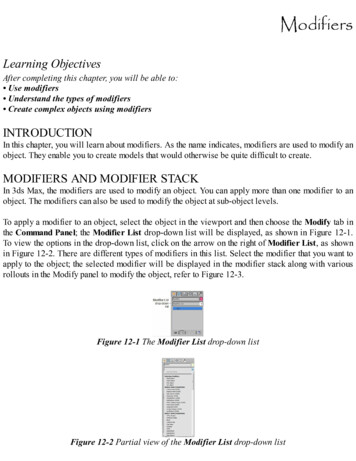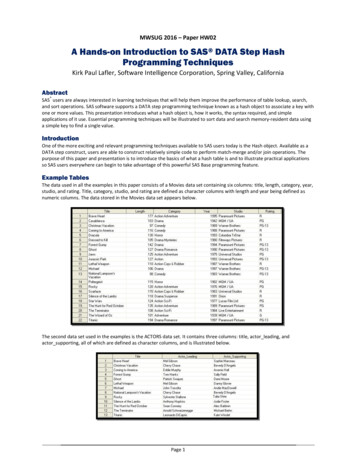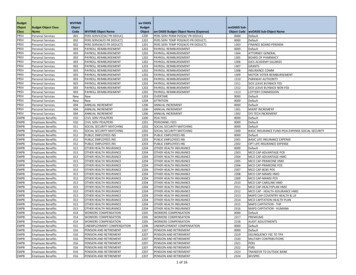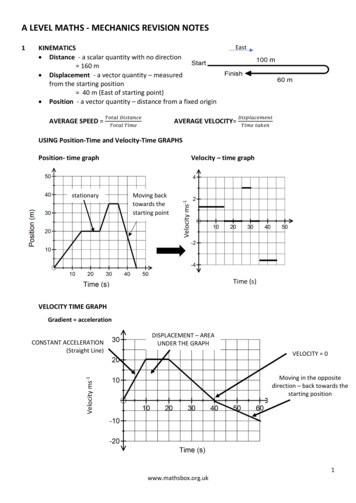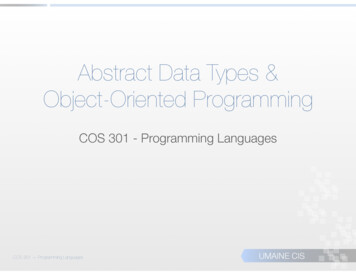
Transcription
Abstract Data Types &Object-Oriented ProgrammingCOS 301 - Programming LanguagesCOS 301 — Programming LanguagesUMAINE CIS
Chapters 11 & 12 in the bookSlides are heavily based on Sebesta’s slides forthe chapters, with much left out!COS 301 — Programming LanguagesUMAINE CIS
Abstract data types & The Concept of AbstractionIntroduction to Data AbstractionDesign Issues for Abstract Data TypesLanguage ExamplesParameterized Abstract Data TypesEncapsulation ConstructsNaming EncapsulationsCOS 301 — Programming LanguagesUMAINE CIS
Abstraction View/representation of entity that includes onlymost significant attributes Abstraction fundamental for CSProcess abstraction: functions & subroutines, e.g.nearly all languagesFrom the 80s — most languages support dataabstraction as wellCOS 301 — Programming LanguagesCopyright 2012 Addison-Wesley. All rights reserved.UMAINE CIS1-3
Abstract data type (ADT)No, not that ADT COS 301 — Programming LanguagesCopyright 2012 Addison-Wesley. All rights reserved.UMAINE CIS1-4
Abstract data type (ADT) Abstract data type: class of data types defined bya set of values and behavior/operations E.g., lists, queues, stacks Sometimes: includes time complexity in definitionWith respect to a programming language: userdefined data type that: hides the representation of “objects” — onlyoperations possible are provided by the type single syntactic unit contains the declarations ofthe type and of any operations on itCOS 301 — Programming LanguagesCopyright 2012 Addison-Wesley. All rights reserved.UMAINE CIS1-4
Advantages Advantages of hiding data: reliability: user code can’t access internals, thuscompromising other users’ use of object flexibility: since user code can’t access internals, internalscan be changed to improve performance w/o affecting users reduced name conflictsAdvantages having single syntactic unit for type: Provides way to organize program Separate compilation, debuggingEnhances modifiability: everything needed for data structureis together in one placeCOS 301 — Programming LanguagesUMAINE CIS
ADT language requirements Syntactic unit for encapsulating definition Primitive operations on types must be part of thecompiler/interpreterWay to make type names, method/subprogramheaders available while hiding definitionsCOS 301 — Programming LanguagesUMAINE CIS
Design issues What does the container for the interface to thetype look like? Can abstract types be parameterized?What access controls are provided?Is specification of the type separate from itsimplementation?COS 301 — Programming LanguagesUMAINE CIS
Language example: Ada Encapsulation construct: package Interface: specification packageImplementation: body packageInformation hiding — public and private parts of specificationpackage Public part: name, maybe representation of any unhidden typesPrivate part: representation of the abstract type limited private types have no built-in operationsprivate types have built-in operations for assignment,comparisonCOS 301 — Programming LanguagesUMAINE CIS
Ada specificationpackage Stack Pack istype stack type is limited private;max size: constant : 100;function empty(stk: in stack type) return Boolean;procedure push(stk: in out stack type; elem: in Integer);procedure pop(stk: in out stack type);function top(stk: in stack type) return Integer;//private-- hidden from clientstype list type is array (1.max size) of Integer;type stack type is recordlist: list type;topsub: Integer range 0.max size) : 0;end record;end Stack PackCOS 301 — Programming LanguagesUMAINE CIS
Ada bodywith Ada.Text IO; use Ada.Text IO;package body Stack Pack isfunction Empty(Stk : in Stack Type) return Boolean isbeginreturn Stk.Topsub 0;end Empty;procedure Push(Stk: in out Stack Type;Element : in Integer) isbeginif Stk.Topsub Max Size thenPut Line(″ERROR – Stack overflow″);elseStk.Topsub : Stk.Topsub 1;Stk.List(Topsub) : Element;end if;end Push; end Stack Pack;COS 301 — Programming LanguagesUMAINE CIS
C example Encapsulation is via classes Each instance has its own copy of class datamembers (instance variables) Instances can be static, stack dynamic, or heapdynamicADT based on C struct, Simula 67 classClasses are typesAll instances of a class share copy of memberfunctions (methods)COS 301 — Programming LanguagesUMAINE CIS
C example Information hiding: Private clause for hidden entitiesPublic clause for interface entitiesProtected clause for inheritance (later) Constructors: Destructors: Functions to initialize the data members — they don’t create objects May also allocate storage if part of the object is heap-dynamic Can include parameters to provide parameterization of the objects Implicitly called when an instance is created — but can be called explicitly, too Name is the same as the class name Clean up after an instance is destroyed — usually just to reclaim heap storage Implicitly called when the object’s lifetime ends, or explicitly called Name is the class name, preceded by a tilde ( )COS 301 — Programming LanguagesUMAINE CIS
C example: Header file// Stack.h - the header file for the Stack class#include iostream.h class Stack {private: //** These members are visible only to other//** members and “friends” (see textbook)int *stackPtr;int maxLen;int topPtr;public://** These members are visible to clientsStack();//** A constructor Stack();//** A destructorvoid push(int);void pop();int top();int empty();}COS 301 — Programming LanguagesCopyright 2012 Addison-Wesley. All rights reserved.UMAINE CIS1-17
C example: Code fileclass Stack {private:int *stackPtr, maxLen, topPtr;public:Stack() { // a constructorstackPtr new int [100];maxLen 99;topPtr -1;}; Stack () {delete [] stackPtr;};void push (int number) {if (topSub maxLen)cerr ″Error in push - stack is full\n″;else stackPtr[ topSub] number;};void pop () { };int top () { };int empty () { };}COS 301 — Programming LanguagesUMAINE CIS
C example: Friends Friend functions or classes Allow access to private members fromunrelated units Necessary in C COS 301 — Programming LanguagesCopyright 2012 Addison-Wesley. All rights reserved.UMAINE CIS1-19
Objective-C Based on C, SmalltalkClasses, which are typesInterfaces (C-like .h file):@interface class-name: parent-class {instance variable declarations}method prototypes@end Implementations (.m file):@implementation class-namemethod definitions@endCOS 301 — Programming LanguagesCopyright 2012 Addison-Wesley. All rights reserved.UMAINE CIS1-20
Objective-C example Method prototypes( -) (return-type) method-name [: (formal-parameters)]; /- for class/instance methods (resp.) Colon, parentheses — not included when no parameters Odd nomenclature: One parameter: Ex: (int) foo: (int) x; Name of method is foo: Message: (call): [objectName foo: 3] x 3 Two parameters: Ex: (int) foo: (int) x bar: (float) y; Name of method is foo:bar: Message: [objectName foo: 3 bar: 4.5] x 3, y 4.5COS 301 — Programming LanguagesUMAINE CIS
Objective-C example Initializers: constructors Only initialize variables Initializers return the instance itselfCan have any name, and are only explicitlycalledCreate object call alloc initializerAdder *myAdder [[Adder alloc] init]; All class instances are heap dynamicCOS 301 — Programming LanguagesCopyright 2012 Addison-Wesley. All rights reserved.UMAINE CIS1-23
Objective-C example Standard prototypes (e.g., for I/O):#import Foundation/Foundation.h Program must initialize a pool for its storage:NSAutoreleasePool *pool [[NSAutoreleasePool alloc] init]; NSxxx — from NextStepAt program end, release storage:[pool drain];COS 301 — Programming LanguagesUMAINE CIS
Objective-C — information @public, @private, @protected — specify instance variable access @public: accessible anywhere@private: accessible only in class where defined@protected: accessible in that class and any subclassesDefault access is @protectedHowever: no really good way to restrict access to methodsGetter and setter methods for instance variables Name of getter is always name of instance variable Can be implicitly generated if no additional constraints to be defined— called “properties” in this caseName of setter is always the word set with the capitalized variablename attached (e.g., setFoo)COS 301 — Programming LanguagesUMAINE CIS
Objective-C — another// stack.m – interface and implementation for asimple stack@implementation Stack-(Stack *) initWith {#import Foundation/Foundation.h maxLen 100;@interface Stack: NSObject {topSub -1;stackPtr stackArray;int stackArray[100], stackPtr,maxLen, topSub;return self;}}-(void) push: (int) number;-(void) push: (int) number {if (topSub maxLen)-(void) pop;NSLog(@″Stack is full″);-(int) top;elsestackPtr[ topSub] number;-(int) empty;.@end}@endCOS 301 — Programming LanguagesUMAINE CIS
Using the stack ADTint main (int argc, char *argv[]) {int temp;NSAutoreleasePool *pool [[NSAutoreleasePool alloc] init];Stack *myStack [[Stack alloc] initWith];[myStack push: 5];[myStack push: 3];temp [myStack top];NSLog(@″Top element is: %i″, temp);[myStack pop];temp [myStack top];NSLog(@″Top element is: %i″, temp);temp [myStack top];myStack pop];[myStack release];[pool drain];return 0;}COS 301 — Programming LanguagesUMAINE CIS
Java Similar to C , except: All user-defined types are classesAll objects are heap-dynamicAll objects accessed via reference variablesAccess control modifiers for class entitiesPackage scope: All entities in all classes in package that are notrestricted by access control modifiers visiblethroughout package Eliminates need for C ’s friend functions & classesCOS 301 — Programming LanguagesUMAINE CIS
Java exampleclass StackClass {private int [] stackRef;private int [] maxLen, topIndex;public StackClass() { // a constructorstackRef new int [100];maxLen 99;topPtr -1;};public void push (int num) { };public void pop () { };public int top () { };public boolean empty () { };}// also have “protected”, with same meaning as Objective-CCOS 301 — Programming LanguagesUMAINE CIS
C# Based on C , Java All class instances: heap dynamic structs are lightweight classes that do not supportinheritanceAdds two access modifiers, internal (within project)and protected internal ( protected or internal)Default constructors — available for all classesGarbage collection is used for most heap objects,so destructors are rarely usedCOS 301 — Programming LanguagesUMAINE CIS
C# Getter and setter methods to access data members (instancevariables) Properties: allows implementation of getters/setters without explicitmethod calls ex: assume foo is reference to the instance, bar is aninstance variable property used to access bar in foo:a foo.bar;foo.bar 3.5;COS 301 — Programming Languages// getter// setterUMAINE CIS
Ruby Encapsulation construct: classVariable names: Instance variables: begin with @Class variables: begin with @@Methods: defined with function definition syntax (def end)Constructors: Local: regular identifiersNamed initializeOnly one per classImplicitly called when new is calledIf additional constructors needed: different names, and they must call newClass members can be marked private or public (default)Classes are heap dynamicCOS 301 — Programming LanguagesUMAINE CIS
Ruby exampleclass StackClassdef initialize@stackRef Array.new@maxLen 100@topIndex -1enddef push(number)if @topIndex @maxLenputs " Error in push – stack is full"else@topIndex @topIndex 1@stackRef[@topIndex] numberendenddef pop enddef top enddef empty endendCOS 301 — Programming LanguagesUMAINE CIS
Parameterized ADTs Parameterized ADTs can design an ADT to store any element type(e.g.) only issue for statically-typed languagesAlso known as generic classesSupported in C , Ada, Java (5.0), C# (2005)COS 301 — Programming LanguagesUMAINE CIS
Parameterized ADTs in AdagenericMax Size: Positive;type Elem Type is private;package Generic Stack istype Stack Type is limited private;function Empty(Stk : in Stack Type) return Boolean;function Top(Stk: in out StackType) return Elem type;.privatetype List Type is array (1.Max Size) of Element Type;type Stack Type isrecordList : List Type;Topsub : Integer range 0 . Max Size : 0;end record;end Generic Stack;COS 301 — Programming Languagespackage Integer Stack is new Generic Stack(100,Integer);UMAINE CISpackage Float Stack is new Generic Stack(100,Float);
Parameterized ADTs in C Can make classes somewhat generic withparameterized constructors:Stack (int size) {stk ptr new int [size];max len size - 1;top -1;};Stack stk(150);COS 301 — Programming LanguagesUMAINE CIS
Parameterized ADTs in C — templatestemplate class Type class Stack {private:Type *stackPtr;const int maxLen;int topPtr;public:Stack() { // Constructor for 100 elementsstackPtr new Type[100];maxLen 99;topPtr -1;}Stack(int size) { // Constructor for a given numberstackPtr new Type[size];maxLen size – 1;topSub -1;} }Stack int myIntStack;COS 301 — Programming LanguagesUMAINE CIS
Encapsulation constructs Large programs — two special needs: Some means of organization, other than simplydivision into subprograms Some means of partial compilation — i.e.,compilation units smaller than whole program Group logically-related subprograms into units Such units are encapsulation constructsAllow units to be separately compiled (i.e.,compilation units)COS 301 — Programming LanguagesUMAINE CIS
Nested subprograms as encapsulation One way to organize subprograms: nest them Supported in Ada, Fortran 95 , Python,JavaScript, Ruby, Lisp, Inner subprograms are encapsulated withinouter, but can share variablesCOS 301 — Programming LanguagesCopyright 2012 Addison-Wesley. All rights reserved.UMAINE CIS1-45
Encapsulation in C Encapsulation in C — basically a compilation unit Implementation in .c fileInterface is placed (by convention) in header (.h)file#include — used to include header filesProblem: linker doesn’t check types betweenheader and implementationCOS 301 — Programming LanguagesUMAINE CIS
Encapsulation in C Header & code files, like CAlso has classes Class definition used as the interfaceMember (instance variables, methods) defined inseparate fileFriend functions/classes — provide a way togrant access to private members of a classCOS 301 — Programming LanguagesUMAINE CIS
Encapsulation in Ada Packages — encapsulation unit in Ada Specification, body parts of package can becompiled separatelySpecification packages — any number of data,subprogram definitionsCOS 301 — Programming LanguagesUMAINE CIS
Encapsulation in C# Assembly: collection of files that appears as a single executable or dynamic link library (DLL) Microsoft’s version of shared librariescollection of classes, methods (in C#) that areindividually linked to an executing program Each file contains module that can be separatelycompiled Internal access modifier: member is visible to allclasses in the assemblyCOS 301 — Programming LanguagesCopyright 2012 Addison-Wesley. All rights reserved.UMAINE CIS1-49
Naming encapsulations Large programs: define many global namesneed way to divide into logical groups Naming encapsulation: used to create a new scopefor names C namespaces Can place each library in its own namespace C# also includes namespacesQualify names used outside with their namespace, e.g.,foo::bar, foo::bazCOS 301 — Programming LanguagesUMAINE CIS
Naming encapsulations Java — packages Package contains one or more class definitionsClasses within package are partial friendsClients of a package — use fully qualified name or usethe import declarationAda — packages Packages are defined in hierarchies which correspondto file hierarchies Visibility from a program unit is gained with the withclauseCOS 301 — Programming LanguagesUMAINE CIS
Naming encapsulations Ruby: Classes, but also modules Modules cannot be instantiated or subclassed, andthey cannot define variables Methods defined in a module must include themodule’s name Access to the contents of a module is requestedwith the require methodTypically encapsulate collections of constants andmethodsCOS 301 — Programming LanguagesUMAINE CIS
COS 301 — Programming Languages UMAINE CIS Language example: Ada Encapsulation construct: package Interface: specification package Implementation: body package Information hiding — public and private parts of specification package Public part: name, maybe representation of any unhidden types Private part: representation of the abstract type
